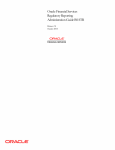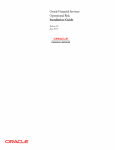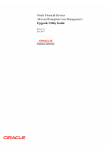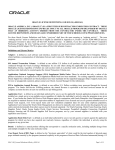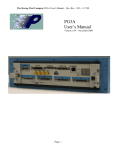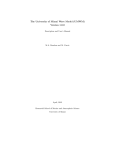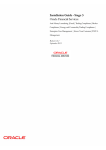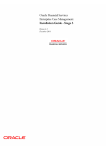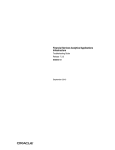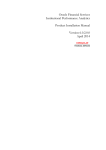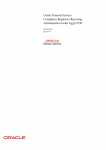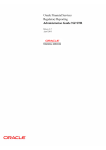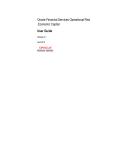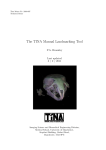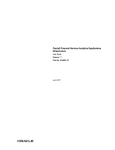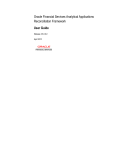Download (OFSAAI) Administration Guide
Transcript
Oracle Financial Services
Analytical Applications
Infrastructure
Administration Guide
DOCUMENT CONTROL
Version Number
Revision Date
Changes Done
Draft
Created: July 2012
Captured the administration configurations for 7.3.2.0.0
Interim Release enhancements.
1.0
Updated: September 2012
Updated the suggested reviewed changes.
1.1
Updated February 2013
Removed the Filter Servlet section from this document
and the same can be obtained by contacting support
team.
1.2
Updated: June 2013
Included Forms Framework enhancement configuration
details.
1.3
Updated: June 2013
Included the following sections:
1.4
1.5
Updated: August 2013
MLS Utility
Included the following sections:
Updated: September 2013
Config Schema Upload/ Download Settings
Database Password Reset/ Change
Removed some sections and added those as FAQs in
Installation Guide.
1.6
Updated November 2013
Updated MLS Utility section.
1.7
Updated December 2013
Added Configure SSO Authentication section.
Created by:
Reviewed by:
Approved by:
Anand / Gitcy
Bharath / Lokesh/ Sue
Jeevraj / Surag Ramachandran / Subhashini
Executive Summary
This document includes the necessary instructions for module specific configurations. We
recommend you to download the latest copy of this document from OTN library which includes all
the recent revisions (if any) done till date.
Oracle Financial Services Software Confidential - Restricted
ii
Table of Contents
TABLE OF CONTENTS
1
OFSAAI ADMINISTRATION ...................................................................................................................... 4
1.1
1.2
Dimension Configuration: Alphanumeric and Numeric Codes ...................................................................5
1.1.1
Configure Alphanumeric Dimensions ............................................................................................................. 6
1.1.2
Configure Numeric Dimensions ...................................................................................................................... 8
1.1.3
Configure Alphanumeric Code in Simple Dimension Tables ........................................................................... 9
1.1.4
Create Index on Code Column ..................................................................................................................... 10
Hierarchy Node Internationalization ......................................................................................................... 10
1.2.1
Scope .......................................................................................................................................................... 10
1.2.2
Prerequisites ................................................................................................................................................ 10
1.2.3
Multi Language Support (MLS) Table ........................................................................................................... 11
1.2.4
Node Generation Process ............................................................................................................................ 14
1.2.5
Configure Mapper for Multiple Locales ......................................................................................................... 14
1.2.6
Update Nodes in Existing Regular BI and PC Hierarchies ............................................................................ 15
1.2.7
Limitations.................................................................................................................................................... 15
1.3
T2T and PR2 Query Performance Optimization ....................................................................................... 16
1.4
Configure Data Quality Rule Approval Parameters .................................................................................. 17
1.5
Run Rule Framework Configuration ......................................................................................................... 17
1.5.1
Enable RRF/PR2 Links in OFSAAI ............................................................................................................... 17
1.5.2
Command Line Utilities ................................................................................................................................ 18
1.5.3
Component Registration............................................................................................................................... 19
1.6
Configure Forms xml to execute Server Side Rule .................................................................................. 25
1.7
Data Element Filters Classification........................................................................................................... 25
1.7.1
1.8
Limitations.................................................................................................................................................... 26
Configure Forms Framework Enhancements ........................................................................................... 27
1.8.1
Performance Optimization in Forms Framework ........................................................................................... 34
1.9
Multiple Language Support (MLS) Utility .................................................................................................. 35
1.10
Config Schema Upload/ Download Settings ............................................................................................ 38
1.11
Database Password Reset/ Change ........................................................................................................ 38
1.12
Configure SSO Authentication ................................................................................................................. 39
Oracle Financial Services Software Confidential - Restricted
iii
Administration Guide
1
OFSAAI Administration
This section consists of information related to module specific configurations. You can refer to the
required sections appropriately.
•
Dimension Configuration: Alphanumeric and Numeric Codes
•
Hierarchy Node Internationalization
•
T2T and PR2 Query Performance Optimization
•
Configure Data Quality Rule Approval Parameters
•
Run Rule Framework Configuration
•
Configure Forms xml to execute Server Side Rule
•
Data Element Filters Classification
•
Configure Forms Framework Enhancements
•
Multiple Language Support (MLS) Utility
•
Config Schema Upload/ Download Settings
•
Database Password Reset/ Change
•
Configure SSO Authentication
Conventions and Acronyms
Conventions
Description
Actions are indicated in Bold
AIX
Advanced Interactive eXecutive
EPM
Enterprise Performance Management
KBD
Key Business Dimensions
OEL
Oracle Enterprise Linux
OFSAAI
Oracle Financial Services Analytical Applications Infrastructure
RHEL
Red Hat Enterprise Linux
SQL
Structured Query Language
UDP
User Defined Properties
UMM
Unified Metadata Manager
T2T
Table to Table
Oracle Financial Services Software Confidential - Restricted
4
Administration Guide
1 .1
Conventions
Description
RRF
Run Rule Framework
Dimension Configuration: Alphanumeric and Numeric Codes
This section explains the configuration changes for Alphanumeric Code enhancements
introduced as part of 7.3.1.0.0 IR.
OFSAAI supports both numeric and alphanumeric dimensions. Both dimension types require a
numeric member code. An alphanumeric dimension will additionally store an alphanumeric
member code. A numeric dimension can optionally store an alphanumeric code as well, but it will
be equivalent to the numeric code value.
After the successful installation of this IR, you may need to run SQL updates on the
REV_DIMENSIONS_B table. This table stores the required dimension metadata including
dimension member data type and the member column names for dimension member tables
where the numeric and alphanumeric codes are stored.
In the REV_DIMENSIONS_B table:
The column MEMBER_DATA_TYPE_CODE with value ’NUMBER’ identifies a dimension
as numeric and value ‘VARCHAR2’ identifies a dimension as alphanumeric.
MEMBER_CODE_COLUMN specifies the member table column which holds the
alphanumeric member code. This is optional for numeric dimensions, where alphanumeric
and numeric member codes would be equivalent.
MEMBER_COL specifies the numeric member code column.
NOTE:
Any change done in REV_DIMENSIONS_B table requires web server restart since, the
dimension definitions data in cache memory has to be refreshed.
A new installation by default will have the seeded key dimensions configured as numeric,
although those dimension member tables include a column for alphanumeric member codes. You
can configure any of these dimensions as alphanumeric. For more information refer to Configure
Alphanumeric Dimensions.
You might also need to run some SQL updates for numeric dimensions. For more information
refer to Configure Numeric Dimensions.
Oracle Financial Services Software Confidential - Restricted
5
Administration Guide
1.1.1 Configure Alphanumeric Dimensions
To configure an editable (numeric) dimension as alphanumeric and to remove the optional code
attribute from prior releases you have to back up the affected dimension tables (like
REV_DIMENSIONS_B,
REV_DIM_ATTRIBUTES_B,
REV_DIM_ATTRIBUTES_TL,
and
DIM_<DIMENSION>_ATTR) and perform the following steps on each applicable dimension.
1. Set the member type as alphanumeric (VARCHAR2) in REV_DIMENSIONS_B, and
identify the member table’s alphanumeric code column name if it is not populated
already.
Update REV_DIMENSIONS_B SET
Member_Data_Type_Code
=
’VARCHAR2’
[,
Member_Code_Column
=
‘{Alphanumeric Column Name}’] Where Dimension_ID = {Dimension
ID}
Example:
Update REV_DIMENSIONS_B SET
Member_Data_Type_Code
=
'VARCHAR2',
Member_Code_Column
=
'TP_PRODUCT_CODE' Where Dimension_ID = 5;
NOTE: In OFSAAI 7.3, the seeded key dimensions have already populated
MEMBER_CODE_COLUMN.
2. If there is an associated code attribute which is present from OFSAAI release 7.3 for
capturing the alphanumeric member code, remove it manually as follows:
If the attribute currently contains values:
Update the alphanumeric codes from the attribute table to the Member Code
Column of the member table.
I.e. Execute the Update_Dimension_Code procedure using steps detailed in the
Data Model Utilities Guide. For example: Either run fn_updateDimensionCode
from SQL Plus or use a Batch to run TRANSFORM DATA with the
Update_Dimension_Code procedure for your Dimension ID.
Remove the attribute values from the dimension attribute table
(DIM_<DIMENSION>_ATTR).
For example, if you are updating the Common Chart of Accounts Dimension, where
Attribute
Name
is
‘COMMON
‘DIM_COMMON_COA_B’,
COA
and
CODE’,
Attribute
Member_B_Table_Name
Table
‘DIM_COMMON_COA_ATTR’, execute the following statement:
Oracle Financial Services Software Confidential - Restricted
6
Name
is
is
Administration Guide
Delete
(Select
from
DIM_COMMON_COA_ATTR
Attribute_ID
Attribute_Name
(select
=
from
'COMMON
dimension_id
where
Attribute_ID
REV_DIM_ATTRIBUTES_TL
COA
CODE'
from
and
where
dimension_id
REV_DIMENSIONS_B
=
=
where
member_b_table_name = 'DIM_COMMON_COA_B'));
Remove the attribute definition from REV_DIM_ATTRIBUTES_B &
REV_DIM_ATTRIBUTES_TL tables. This is necessary to prevent the Dimension
Member UI from showing the code as an optional attribute, since it already displays
the alphanumeric and numeric codes based on the member table.
Delete alphanumeric attribute metadata from ATTRIBUTE_B table.
Example:
Delete from REV_DIM_ATTRIBUTES_B where Attribute_ID = (Select
Attribute_ID from REV_DIM_ATTRIBUTES_TL where Attribute_Name
= 'COMMON COA CODE' and dimension_id = (select dimension_id
from
REV_DIMENSIONS_B
where
member_b_table_name
=
'DIM_COMMON_COA_B'));
Delete alphanumeric attribute metadata from ATTRIBUTE_TL table.
Example:
Delete
(Select
from
REV_DIM_ATTRIBUTES_TL
Attribute_ID
from
where
Attribute_ID
REV_DIM_ATTRIBUTES_TL
=
where
Attribute_Name = 'COMMON COA CODE' and dimension_id = (select
dimension_id from REV_DIMENSIONS_B where member_b_table_name
= 'DIM_COMMON_COA_B'));
3. In case any rows in the Dimension member table contain a null alphanumeric code
even after running the fn_updateDimensionCode procedure, you need to manually
run an SQL update as illustrated in the example below:
Update
DIM_GENERAL_LEDGER_B
set
GL_Account_Code
GL_Account_ID Where GL_Account_Code is null;
Commit;
4. Save your changes using Commit;
Oracle Financial Services Software Confidential - Restricted
7
=
Administration Guide
1.1.2 Configure Numeric Dimensions
If REV_DIMENSIONS_B.Member_Code_Column is populated for a dimension, any UI which
displays an alphanumeric code will look in the specified column for the member's alphanumeric
code. If REV_DIMENSIONS_B.Member_Code_Column is null, the UI will assume no
alphanumeric code column exists in the member table and will display the alphanumeric code
with the same value as the numeric code. Therefore, for numeric dimensions, you may want to
update the metadata.
There are two options available to configure Numeric dimension.
Option 1: When the dimension does not have <DIM>_CODE column in <DIM>_B table
Option 2: When the dimension have <DIM>_CODE column in <DIM>_B table
NOTE:
By default, there may not be configuration changes required in Rev_Dimensions_B for
Numeric dimension, since the REV_DIMENSIONS_B.MEMBER_CODE_COLUMN
column would have value either <Dim>_Code or null depending on the availability of
<Dim>_Code column.
Option 1: When the dimension does not have <DIM>_CODE column in <DIM>_B table. In this
case, the alphanumeric and numeric code value are stored in the same <DIM>_ID column.
Back up the table REV_DIMENSIONS_B, if you have not done it already.
Clear the Member Code Column entries for applicable dimensions.
Example:
For specific numeric dimensions:
Update
REV_DIMENSIONS_B
Set
Member_Code_Column
=
null
Where
Member_Code_Column
=
null
Where
Dimension_ID in([values]);
Commit;
For all editable numeric dimensions:
Update
REV_DIMENSIONS_B
Set
Member_Data_Type_Code = 'NUMBER' and DIMENSION_EDITABLE_FLAG =
'Y';
Commit;
NOTE:
If the dimension have <Dim>_Code column and Option 1 is used (i.e. the
REV_DIMENSIONS_B.MEMBER_CODE_COLUMN is set to null), this will cause the
dimension loaders and seeded T2T extracts to fail.
Oracle Financial Services Software Confidential - Restricted
8
Administration Guide
Option 2: When the dimension have <DIM>_CODE column in <DIM>_B table. In this case, the
alphanumeric and numeric code value are stored separately in <DIM>_CODE and <DIM>_ID
column (though both the values are same).
Back up the table REV_DIMENSIONS_B, if you have not done it already.
Populate the Member Code Column entries for applicable dimensions.
Example:
For specific numeric dimensions:
Update
REV_DIMENSIONS_B
Set
Member_Code_Column
=
<dim>_code
=
<dim>_code
Where Dimension_ID in([values]);
Commit;
For all editable numeric dimensions:
Update
REV_DIMENSIONS_B
Where
Set
Member_Code_Column
Member_Data_Type_Code
=
'NUMBER'
and
DIMENSION_EDITABLE_FLAG = 'Y';
Commit;
For upgrades from 7.3 release, if data already exists for numeric dimension members, copy the
numeric code values to the alphanumeric code column.
Example:
For the General Ledger Account dimension:
Update DIM_GENERAL_LEDGER_B set GL_Account_Code = GL_Account_ID;
Commit;
1.1.3 Configure Alphanumeric Code in Simple Dimension Tables
For some editable seeded and user-defined simple dimensions, the alphanumeric code column
currently might not be present in the data model. To add this column to a user-defined simple
dimension table, you can use Model Upload. You will also need to update the
REV_DIMENSIONS_B table as indicated in Dimension Configuration section, to configure
alphanumeric properties.
NOTE: You should not modify the structure of any seeded simple dimensions.
Oracle Financial Services Software Confidential - Restricted
9
Administration Guide
1.1.4 Create Index on Code Column
You need to create a unique index on the alphanumeric code column if such an index is does not
exist. Also while creating, you need to ensure that this index uniqueness should be case
insensitive.
Example:
Create
unique
index
IDX1_DIM_PRODUCTS_B
on
DIM_PRODUCTS_B
Upper(PRODUCT_CODE)
Commit;
1 .2
Hierarchy Node Internationalization
This enhancement is included as part of OFSAAI 7.3.2.0.0 IR Patch Update.
Hierarchy Node Internationalization is an enhancement brought into the Business Hierarchy
section of the Oracle Financial Services Analytical Applications Infrastructure. This feature is
introduced to internationalize the node description of Regular Business Intelligence Enabled (BI)
and Parent Child (PC) Hierarchies and to display them in Hierarchy Browser.
Previously, node descriptions were fetched from the Description column of the Dimension table
(<DIM> table) to facilitate the node generation in REV_LOCALE_HIER table. Each Node has a
description. Hierarchy node Internationalization enhancement changes the way in which the
descriptions are stored in the REV_LOCALE_HIER. The locale specific node descriptions are
fetched from Multi Language Support tables (<DIM>_MLS table). This table holds the node
descriptions in all the installed locale, that is, in the locales in which OFSAAI is available.
1.2.1 Scope
The scope of this enhancement is limited to the Hierarchy Browser window. The hierarchies
defined are displayed in Hierarchy Browser and the Hierarchy Browser is used in other modules/
screens such as Unified Metadata Manager, Rules Framework, Metadata Browser, Map
Maintenance, Forms Framework, and Hierarchy Maintenance.
1.2.2 Prerequisites
The following are the prerequisites for creating a Hierarchy with Multi Language Support
Descriptions:
The Hierarchy under creation should be either Regular Business Intelligence Enabled (BI)
or Parent Child (PC).
The Multi Language Support table <DIM>_MLS should be created either through Data
Model Upload or manually in atomic schema. For more information on <DIM>_MLS table
and structure, refer to Multi Language Support (MLS) Table.
Oracle Financial Services Software Confidential - Restricted
10
Administration Guide
The Description columns used for node generation should be of Varchar / Varchar2 data
type.
1.2.3 Multi Language Support (MLS) Table
The <DIM>_MLS tables are created by appending “_MLS” to the existing <DIM> table name.
NOTE:
1.2.3.1
The insertion of data into <DIM>_MLS tables should be performed manually.
<DIM>_MLS Table Structure
The <DIM>_MLS table created for a <DIM> table entirely depends on the structure of the <DIM>
table. The following points must be followed during <DIM>_MLS table creation.
Description columns on which the Hierarchy definition is based should also be present in
the <DIM>_MLS table.
A column namely DESCLOCALE of data type Varchar / Varchar2 should be present in the
<DIM>_MLS table. This column should contain the information about the locale (such as
fr_FR, ko_KR) and should be part of the composite primary key.
The primary key of the <DIM>_MLS table is formed by the columns which are the primary
keys of <DIM> table, along with an additional column namely DESCLOCALE. Ensure that
the column names are same in both the tables.
Example:
Consider a Hierarchy “Income” defined on table “DIM_INCOME”. The table structure is as
indicated:
Column Name
Primary Key
Datatype
N_CUST_INCOME_BAND_CODE
PK
Number(5,0)
FIC_MIS_DATE
Date
V_CUST_INCOME_SHORT_DESC
Varchar2(80)
V_INCOME_DESC
Varchar2(80)
N_D_INCOME_UPPER_VALUE
Number(22,3)
N_D_INCOME_LOWER_VALUE
Number(22,3)
The primary key of DIM_INCOME table is PK_DIM_INCOME and is created using
N_CUST_INCOME_BAND_CODE.
Oracle Financial Services Software Confidential - Restricted
11
Administration Guide
The following figure represents the Income Hierarchy definition:
<DIM>_MLS table corresponding to the DIM_INCOME can be created as mentioned below:
The <DIM>_MLS table would be DIM_INCOME_MLS with columns:
N_CUST_INCOME_BAND_CODE
V_INCOME_DESC (both columns are used in DIM_INCOME table)
DESCLOCALE
All the columns which act as the primary key in the DIM_INCOME table should also be created in
DIM_INCOME_MLS table and the data type of these columns in both tables should be the same.
The structure of the DIM_INCOME_MLS table would be as follows:
Column Name
Primary key
Datatype
N_CUST_INCOME_BAND_CODE
PK
Number(5,0)
V_INCOME_DESC
DESCLOCALE
Varchar2(80)
PK
Varchar2(30)
The following table displays sample data which can be populated in DIM_INCOME_MLS table in
a setup where there are 2 locales installed i.e. English (en_US) and Chinese (zh_CN).
Oracle Financial Services Software Confidential - Restricted
12
Administration Guide
N_CUST_INCOME_BAND_CODE
V_INCOME_DESC
DESCLOCALE
1
AAA
en_US
2
BBB
en_US
1
CCC
zh_CN
2
DDD
zh_CN
Note the following:
The <DIM> table name should not exceed 26 characters as the corresponding
<DIM>_MLS table name would need four more characters (_MLS) and the Oracle table
nomenclature allows maximum of 30 characters. Any Dimension table names with more
than 26 characters in length have to be reduced to 26 characters if this enhancement needs
to be configured for that <DIM> table and the Hierarchy based on it. This change would
require a Data model change and the possible impacts of this across AAI should be
addressed.
The expression created in Level Description field should not contain any CASE
statements.
In Regular BI enabled and PC Hierarchies, the Level Description expression should not
contain columns with Number or Date data types. The inclusion of such a column in the
Level Description expression would prevent the Business Hierarchy from generating nodes.
There is no concept of default locale. Whenever a Hierarchy is saved, the translated node
descriptions present in <DIM>_MLS table are saved in the corresponding columns of the
REV_LOCALE_HIER table depending on the availability of translated values in the
<DIM>_MLS table.
The inclusion or exclusion of nodes from a Hierarchy will be reflected in Forms once the
Hierarchy is resaved.
Oracle Financial Services Software Confidential - Restricted
13
Administration Guide
1.2.4 Node Generation Process
During Hierarchy definition, the nodes get generated depending on the structure of the Hierarchy.
Node generation is possible in the following two scenarios:
1.2.4.1
Node Generation when <DIM>_MLS Table is Present
Node Generation when <DIM>_MLS Table is Not Present
Node Generation when <DIM>_MLS Table is Present
When <DIM>_MLS table is present, the nodes are generated by fetching the Description from the
<DIM>_MLS table. Thus, entry in the Description column is mandatory.
1.2.4.2
Node Generation when <DIM>_MLS Table is Not Present
When <DIM>_MLS table is not present, by default the nodes are generated by fetching the
Description from the <DIM> table.
1.2.5 Configure Mapper for Multiple Locales
This step is optional and is required if Node Generation Process explained in the above section is
done.
To configure mapper for multiple locales:
1. Duplicate the data in REVELEUS_MASTER table with different locales in LOCALE_ID
column.
2. Translate V_OBJECT_DESC column in REVELEUS_MASTER table to the desired
locale.
3. Duplicate data in LOCALE_ID column in REV_MAST_MAP_ITEMS table for different
LOCALE_ID.
Example:
An existing mapper namely Mapper A (created in any locale) can be translated into other locales
as indicated in the following example:
1. Login to the configuration schema and duplicate the data in REVELEUS_MASTER
table by changing the locale in LOCALE_ID column.
2. Change V_OBJECT_DESC for the corresponding locale in REVELEUS_MASTER
table.
3. Duplicate the data in REV_MAST_MAP_ITEMS table by changing Locale in
LOCALE_ID column.
Oracle Financial Services Software Confidential - Restricted
14
Administration Guide
NOTE:
nd
2
th
and 4 steps need to be performed for all the locales to which you wish to
translate mapper A.
1.2.6 Update Nodes in Existing Regular BI and PC Hierarchies
Currently, the node description is generated only for one locale on which the Hierarchy is saved.
With the introduction of Hierarchy Node Localization, the nodes will be generated in all the
installed locales.
To generate the localized node descriptions for the existing Hierarchies, you need to edit and resave the Hierarchies post <DIM>_MLS table creation. You can also mass update the existing
Hierarchies from Administration > Save Metadata section. The node description data for all the
installed locales will be populated in REV_LOCALE_HIER table.
NOTE:
If an SCD (Slowly Changing Dimension) is configured on a <DIM> table, synchronize
the new entries with the corresponding <DIM>_MLS table also.
1.2.7 Limitations
If the Hierarchies are accessed via Modeling Framework module, the node descriptions of the
same will be displayed only in English, despite the locale you have logged in to the application.
Oracle Financial Services Software Confidential - Restricted
15
Administration Guide
1 .3
T2T and PR2 Query Performance Optimization
This enhancement is included as a part of OFSAAI 7.3.2.0.0 IR Patch Update.
A configuration file, OracleDB.conf has been introduced to accommodate any configurable
parameter related to operations for Oracle database. If you do not want to set a parameter to a
specific value, then the respective parameter entry can be removed/commented from the
OracleDB.conf file which resides in the path $FIC_DB_HOME/conf.
The following table details the configurable OFSAA parameters in OracleDB.conf file with its
purpose, and the way it maps to Oracle Database Parallelism settings.
Parameters
Description
Sets the parallel degree policy.
Possible values – MANUAL, LIMITED, or AUTO.
CNF_PARALLEL_DEGREE_POLICY
Query
fired
on
the
database
-
ALTER
SESSION
SET
PARALLEL_DEGREE_POLICY=<<CNF_PARALLEL_DEGREE_POLICY>>
Sets parallelism for queries.
Possible values – DISABLE, ENABLE, or FORCE.
CNF_PARALLEL_QUERY
Query
fired
on
the
database
-
ALTER
SESSION
ALTER
SESSION
<<CNF_PARALLEL_QUERY>> PARALLEL QUERY
Sets parallelism for DML operations.
Possible values – DISABLE, ENABLE, or FORCE.
CNF_PARALLEL_DML
Query
fired
on
the
database
-
<<CNF_PARALLEL_QUERY>> PARALLEL DML
Sets the degree of parallelism.
Possible values – Value can be any positive integer.
The default mode of a session is DISABLE PARALLEL DML. If
CNF_DEGREE_OF_PARALLELISM is not set, then the default degree, as
decided by Oracle will be used.
CNF_DEGREE_OF_PARALLELISM
Queries
fired
on
the
<<CNF_PARALLEL_QUERY>>
database
PARALLEL
-
ALTER
QUERY
SESSION
PARALLEL
<<CNF_DEGREE_OF_PARALLELISM>>
ALTER
SESSION
<<CNF_PARALLEL_QUERY>>
PARALLEL
DML
PARALLEL <<CNF_DEGREE_OF_PARALLELISM>>
For more information, refer Oracle Database VLDB and Partitioning Guide - 11g Release 2 (11.2)
Chapter 8 - Using Parallel Execution section.
Oracle Financial Services Software Confidential - Restricted
16
Administration Guide
1 .4
Configure Data Quality Rule Approval Parameters
This enhancement is included as a part of OFSAAI 7.3.2.0.0 IR Patch Update.
To facilitate users to edit and delete an approved, not grouped, and non executed Data rule in the
Data Quality framework, you need to set the required configuration parameter. In the config
schema, set ALLOW_CHNG_OF_NONEXEC_DQRULE parameter value to “Y”. This value by
default is set to “Y” unless modified for a specific condition.
1 .5
Run Rule Framework Configuration
The 7.3.2.0.0 IR release includes the enhanced RRF (Run Rule Framework). This framework is a
redesigned version of the earlier PR2 Framework and includes UI and functional enhancements.
This section consists of the following:
Enable RRF/PR2 Links in OFSAAI
Command Line Utilities
Component Registration
1.5.1 Enable RRF/PR2 Links in OFSAAI
In case of OFSAAI 7.3 fresh installation, on successfully installing the 7.3.2.0.0 IR, RRF module
will be enabled by default. For upgrade from older version to v7.3.2.0.0 IR, PR2 module will be
retained if it has been used, else RRF would get enabled.
However, if you wish to enable RRF module in parallel to the existing PR2 module, you need to
execute the below “enable_rrf.sql” script in Config schema of your installation. This enables RRF
in the User Interface.
enable_rrf.sql
In case of a fresh installation, if you wish to enable the PR2 framework, you need to execute the
below “enable_pr2.sql” script in Config schema of your installation. This enables PR2 in User
Interface.
enable_pr2.sql
For using the PR2 metadata in RRF, you need to archive and restore metadata in the new RRF
User Interface. For more information, refer to the PR2 to RRF Migration Guide available at OTN
library.
Further, if you wish to execute the RRF engines you would be required to update the column
F_IS_RRF value in configuration table in Configuration schema to “RRF”.
Oracle Financial Services Software Confidential - Restricted
17
Administration Guide
NOTE:
Once this value is modified, the PR2 engines cannot be executed. In case you need to
execute the PR2 engines, you would be required to switch back the value to “PR2”. For
more information, refer OFSAAI 7.3.2.0.0 User Manual > System Configuration >
Configuration > Others tab. In addition, the value for this parameter needs to be
switched to either RRF/PR2 to use the respective modules.
1.5.2 Command Line Utilities
This section explains the various Command Line Utilities available in OFSAAI 7.3.2.0.0.
Utility Name
Usage
Migration
To Migrate object definitions across Information Domains / Setups.
Currently this utility supports the following object types:
Form - Forms framework definition.
Menu - Forms Menu definition.
Map – Map Maintenance definition.
Rule – Rule definition of RRF.
Process – Process definition of RRF.
Run – Run definition of RRF.
This utility is available under $FIC_HOME/utility/Migration of OFSAAI APP tier post v7.3.2.0.0 IR
patch update.
For usage of this utility, refer Command Line Utilities section in OFSAAI 7.3.2.0.0 User Manual
available at OTN library.
To execute RRF Rule definitions.
This utility is available under $FIC_HOME/utility/RuleExecution of OFSAAI APP tier post v7.3.2.0.0
Rule Execution
IR patch update.
For usage of this utility, refer Command Line Utilities section in OFSAAI 7.3.2.0.0 User Manual
available at OTN library.
Rule
Execution
through
Web
Service
(WSExecution)
To execute RRF Rule definitions through Web Services.
This utility is available under $FIC_HOME/utility/WSExecution of OFSAAI APP tier post v7.3.2.0.0
IR patch update.
For usage of this utility, refer Command Line Utilities section in OFSAAI 7.3.2.0.0 User Manual
available at OTN library.
Oracle Financial Services Software Confidential - Restricted
18
Administration Guide
1.5.3 Component Registration
A Component in the context of OFSAAI is an entity which can be executed individually in
Operations module to carry out some definite job for which it has been formed. Components
within OFSAAI and its application need to be registered so that it is configurable for different
installations with very minimal change.
The component registration process helps you to make the components of Process and Run
module configurable inside Run Rule Framework (RRF). With component registration,
components can be added, modified and deleted from RRF by doing very minimal changes to the
system. For registering a component in RRF, the same should be present in ICC also.
Steps to Register Component
Registering Component has been divided into the following steps respectively:
Component Detailed Implementation Class
Deployment
Entry to PR2_COMPONENT_MASTER Table
1.5.3.1
Component Detailed Implementation Class
The component implementation class has to be made for all the components which are inserted
to the PR2_COMPONENT_MASTER table.
This class has to extend com.ofs.aai.pr2.comp.PR2ComponentProps, in turn to implement the
following methods.
getComponentDescription
getPorbableParamValues (optional)
Implementation of interface com.ofs.aai.pr2.comp.PR2Component is optional. This interface will
be implemented for only the components which can be directly used in a Process or Run. By
implementing this class file following methods has to be over written.
getSummay
getCompDescMap
fillTaskParameter
getUsedTables
Each method takes current username and locale by default.
1.5.3.1.1
getComponentDescription
This method is used to get the description for all the components which are show in the
component tree.
Oracle Financial Services Software Confidential - Restricted
19
Administration Guide
The Input Parameters are:
String username
String locale
Return is:
String
It returns the localized string that has to be displayed for the component in the component tree.
1.5.3.1.2
getPorbableParamValues
This method is used to identify if a parameter input should be a text box or a drop down field.
The Input Parameters are:
String username
String locale
String infodom
Return is:
Map<String, String>
It returns map containing entry key as the value which is shown to the user. The entry value is
stored in database.
1.5.3.1.3
getSummary
This method is used to get all existing definition of the component type existing in the system.
The Input Parameters are:
String username
String locale
String infodom
Return is:
Hashtable<String, Vector<com.ofs.aai.pr2.comp.bean.TaskDefinition>>
It returns a Hashtable of <String, Vector<TaskDefinition>>. Where key denotes any specific sublevels to be shown, which in turn contains a JSON object with compName, compDesc, isDinamic,
levelImg properties for that sub-level and the Vector<TaskDefinition> contains all the data needed
for using the component in a process or run.
Oracle Financial Services Software Confidential - Restricted
20
Administration Guide
1.5.3.1.4
getCompDescMap
This method is used to find all details about all specified definitions.
The Input Parameters are:
String username
String locale
String infodom
Map<String, String> descMap
Boolean allData
Return is:
Map<String, String>
Passed to the method in Map<String, String>, where key is the definition unique code. The value
is a JSON object with defnDesc property with the value same as code. The same JSON has to be
replaced with another JSON object containing defnDesc, defnSubType, defnRef1Name,
defnRef1Value, defnRef2Name, defnRef2Value, defnRef3Name, defnRef3Value, defnRef4Name,
defnRef4Value, defnOptParamName properties. The values populated for these properties as
follows.
Property Name
Description
defnDesc
Populated with <name> for the <code> of the definition, if <name> exists.
If <name> does not exist, then populated with <code>:SD.
If definition does not exist, then populated with <code>:NA.
defnSubType
Sub-Type of the definition
defnRef1Name
Any references which can be used to Identify the definition uniquely. There are four of
defnRef1Value
them. So can be put as name and value pairs.
defnRef2Name
defnRef2Value
defnRef3Name
defnRef3Value
defnRef4Name
defnRef4Value
defnOptParamName
If any optional parameter exits and has to be taken as input from user, then only the
name can be provided by this property.
Oracle Financial Services Software Confidential - Restricted
21
Administration Guide
There is another input called allData, which is a flag. If it is false then only defnDesc has to be
passed and when true all the data has to be passed.
After putting the corresponding JSON Object to its <code> the same map is returned back.
1.5.3.1.5
fillTaskParameter
This method is used to get the parameters for the component which will be used to execute the
component in Operations module.
The Input Parameters are:
String username
String locale
String infodom
String uniqueName
String subtype
Map<String, String> allParams
Return is:
Map<String, String>
It takes uniqueName which is nothing but the <code> of the definition. It also takes subType of
the definition and an allParams which is of data type Map<String, String>. This map contains all
the probable parameters with it, where key is the parameter name and value is the parameter
value. This map contains following params.
Dollar variables ($RUNID, $RUNSK, $EXEID, $RUNEXECID, $MODE).
All reference name and value.
Optional parameter if any.
By using the map another LinkedHashMap will be created in this method with all the parameters
needed to run the component in Operations module. Al the parameter in this map has to be put in
correct order. This LinkedHashMap will be returned back to the calling method.
1.5.3.1.6
getUsedTables
This method is used to get the dependent tables for specified definition of the component type.
The Input Parameters are:
String username
String locale
String infodom
Oracle Financial Services Software Confidential - Restricted
22
Administration Guide
String uniqueName
Map<String, String> allParams
Return is:
Set<String>
It takes uniqueName which is <code> of the definition and the same allParam map which is used
in fillTaskParameter method. By using these inputs a Set<String> will be formed with all the
dependant table data. This data is used to identify a Rule Filter / Process Filter can be applied to
this component. This Set will be returned to the calling method.
1.5.3.2
Deployment
Below steps should be followed for deployment of the component.
1. Place all the image files to the folders mentioned in V_TREE_IMAGE column of
PR2_COMPONENT_MASTER table, relative to <FIC_WEB_HOME>/webroot folder of
the application.
2. The jar containing the component implementation classes has to be placed into
<FIC_WEB_HOME>\webroot\WEB-INF\lib folder.
3. Rebuild and redeploy the application.
1.5.3.3
Entry to PR2_COMPONENT_M ASTER Table
PR2_COMPONENT_MASTER is the table for storing all components which are used in RRF.
You can enter either through backend which is explained here or through UI which is explained in
the Component Registration section under RRF module in the OFSAAI User Guide available at
OTN Library.
An entry contains the following fields.
Column Name
Type
Description
Null
V_PR2_COMPONENT_ID
VARCHAR2(30)
Represents component type in a Process
N
or Run.
V_PR2_COMPONENT_PARENT_ID
VARCHAR2(30)
Indicates
parentage
which
refers
to
Y
V_PR2_COMPONENT_ID.
V_COMPONENT_ID
VARCHAR2(30)
Existing ICC Component Id.
V_PR2_COMPONENT_CLASS
VARCHAR2(100)
Fully
qualified
class
path
Y
of
the
implementation class for this component.
Oracle Financial Services Software Confidential - Restricted
23
N
Administration Guide
Column Name
Type
Description
Null
V_TREE_IMAGE
VARCHAR2(100)
Name with relative path (with respect to
N
web context) of the image which will be
displayed in the component tree.
N_TREE_ORDER
NUMBER(9)
Display order of the component in the tree.
N
The order is done upon the peers.
V_SEEDED_BY
VARCHAR2(8)
Differentiates user created and system
Y
created. The system created will have this
field filled with an application name which
cannot be edited from the front-end utility.
The components created from front-end
utility will not populate any value in this
field which can be edited or deleted from
front-end.
V_CREATED_BY
VARCHAR2(30)
Stores the creator username.
N
D_CREATED_DATE
TIMESTAMP(6)
Stores created date and time.
N
V_LAST_MODIFIED_BY
VARCHAR2(30)
Stores the modifier username.
Y
D_LAST_MODIFIED_DATE
TIMESTAMP(6)
Stores modified date and time.
Y
Example:
insert
into
PR2_COMPONENT_MASTER
V_PR2_COMPONENT_PARENT_ID,
V_TREE_IMAGE,
('COMPTYP',
N_TREE_ORDER,
null,
'Component
V_COMPONENT_ID,
V_SEEDED_BY,
Sample',
(V_PR2_COMPONENT_ID,
V_PR2_COMPONENT_CLASS,
V_CREATED_BY)
'com.sample.ComponentSample',
'sampleImages/sampleComp.gif', 0, 'SEEDEDBY', 'USER')
1.5.3.4
Sample Code
The below file contains the sample code of a created component.
ComponentSample.t
xt
Oracle Financial Services Software Confidential - Restricted
24
values
Administration Guide
1 .6
Configure Forms xml to execute Server Side Rule
This enhancement is included as a part of OFSAAI 7.3.2.0.0 IR Patch Update.
You can execute database stored procedure and PR2 Run using the Forms Framework server
side rule configuration. Post this release you can also include RRF Run to be executed as a
server side rule.
In order to execute RRF Run using Forms xml, the Form where server side rule is being executed
with Type as “REVELEUS_RULE” you need to manually update the Type as “FIRERUN”.
For example, the RiskRecalculate.xml having server side rule is used to re-calculate the risk.
Here the Type needs to be changed as suggested below.
Replace the following attribute Type value:
<RULESET ID="110" TYPE="REVELEUS_RULE">
With
<RULESET ID="110" TYPE="FIRERUN">
1 .7
Data Element Filters Classification
This enhancement is included as a part of OFSAAI 7.3.2.0.0 IR Patch Update.
This section explains the option to categorize “Filter classification Types” as Classified,
UnClassified, or All which can be used to define Data Element filters on Business Metadata
Management objects.
To classify the tables available for a Filter in an existing information domain, perform a Model
upload (Incremental / Sliced / Complete) to trigger object registration, which in turn will populate
all the necessary entries to the registration tables. This is an optional one-time activity required to
register all the tables, so that the tables without classification code are also made available in the
Data Element filters.
During Model upload, Object Registration is done for all Tables and columns.
Tables with the classification code will continue to have entry in REV_TABLE_CLASS_
ASSIGNMENT with the appropriate classification code.
Tables without classification code will also have entry in REV_TABLE_CLASS_
ASSIGNMENT with the value as 1000 (UnClassified).
Once tables are registered successfully, user can go to the Filter screen to Define Data Element
Filters on any tables and columns. Based on the Classification, the appropriate Classification type
option has to be selected in the Data Element Selection screen to list the tables.
Note the following:
Oracle Financial Services Software Confidential - Restricted
25
Administration Guide
If the field value in CLASSIFICATION_FLG column of REV_TABLE_CLASSIFICATION_B
table is set to ‘1’, then it is considered as a Classified table.
By Default, the classification codes 20, 200, 210, 310, 370, 50, 300, and 500 will have the
CLASSIFICATION_FLG set to “1”.
The
REV_TABLE_CLASSIFICATION_TL
table
will
have
an
entry
TABLE_CLASSIFICATION_CD = “1000”, TABLE_DESCRIPTION = “UnClassified” to
identify UnClassified Tables (i.e. tables which are not classified in the Erwin through UDP).
The category “All” option will select all the tables available in the infodom, irrespective of
whether table is classified or not.
Since the above option doesn't check the classification type, So even table which has
CLASSIFICATION_FLG = Blank, in the REV_TABLE_CLASSIFICATION_B table will also
be listed. These tables will not be displayed under Classified or Unclassified Category.
1.7.1 Limitations
Following are the limitations with Data Element Filters classification:
While defining Data Element Filter/Group Filter, it is not recommended to use features like
using an Expression in a Filter and Macro Columns, since the generated SQL query for
these features is unresolved.
Defining Hierarchy/Attribute Filter is not recommended using BMM objects since the
underlying Dimension and Hierarchy data are more specific to EPM Apps, and data will be
available only if EPM Apps are installed in same Information Domain.
Dependency check is not available when any of the BMM objects uses Filters. To maintain
dependency between parent and child objects, an appropriate entry has to be added in to
the REV_OBJECT_DEPENDENCIES table. Since the BMM object definition details are
stored
in
Config
schema,
and
do
not
populate
entry
into
the
FSI_M_OBJECT_DEPENDENCY_B/TL tables, the dependency check will not happen
especially while deleting a Filter.
Oracle Financial Services Software Confidential - Restricted
26
Administration Guide
1 .8
Configure Forms Framework Enhancements
The following enhancements are introduced as a part of 7.3.2.2.0 ML release and the required
configuration to enable these features in Forms Framework module are explained below.
Forms Framework now supports additional set of styles to configure the User
Interface and screen elements. (Bug 16327172)
The required configuration can be done at an application level. In the application, the
Container and Control specific styles can be configured using GroupStyles.
Application level configuration
1. The configurability is decided at the time of choosing the AAI LHS menu option.
Configuration changes are done in the LHS Menu (locale specific) xml file using the
“cssFileName” request parameter.
If the cssFileName value is not defined, then the default stylesheet file is loaded.
CSS_OFSAAI is the new CSS value that gets passed for the parameter.
2. Application users can navigate directly to the application landing page without having to
choose the application link from AAI LHS menu using the “Make my Home Page” option
in AAI home page.
Database values are modified. The request parameter “cssFileName” is appended
to the field “START_PAGE_URL” in Table cssms_start_page_master.
If the cssFileName value is not defined, then the default stylesheet file is loaded.
CSS_OFSAAI is the new CSS value that gets passed for the parameter.
Configuration of Application Elements
Page level elements such as Containers or Controls can be configured using
CssClassName or GroupStyle.
ATTRIBUTE
DESCRIPTION
CSSCLASSNAME
A CSSCLASSNAME is defined for a Container or a Control. It is a single style that is
used to alter the look and feel of a defined element in the Container or the Control.
GROUP_STYLE
A GROUP_STYLE is defined for a Container. It comprises of a group of styles for
every element of the Container.
Example to configure a Container:
<CONTAINER
CREATEDIV="Y"
GROUP_STYLE="lvflv2"
CSSCLASSNAME="formlegend"
ID="5"
NAME=""
NOOFCOLS="2"
VIEWMODE="1" BORDERREQUIRED="N" COLLAPSEREQUIRED="N">
Oracle Financial Services Software Confidential - Restricted
27
WIDTH="25"
TYPE="1"
Administration Guide
Example to configure a Control:
<CSSCLASSNAME
TD_LABEL_STYLE="
className
1"
TD_DATA_STYLE="
className 2">
The seeded Forms now have two additional columns introduced in “Forms_master”
table. (Bug 16542057)
Two additional columns have been introduced in Forms_master table namely Module
(varchar2(200)) and SubModule (varchar2(200)) to distinguish two or more solutions
installed in same information domain.
Grid title can be parameterized based on request parameters. (Bug 16541973)
Existing grid control title can be changed dynamically. For example, on load of a page
ruleset, you can define a rule configuration validation (front end, backend, page loading)
with the proposed function (i.e. setGridTitle) to change the grid title dynamically.
<RULESET ID="111">
<RULE
EXPRESSION="setGridTitle('<Grid
Parent
Form
ID>','<Grid
ControlID>',getParamValWithDiffDelimiter([~queryString],'<Parameter
name passed in request String>'))"/>
<RULESET>
Grid control has been enhanced to load in collapsed mode, even if there is data in
grid container. (Bug 16490089)
On page load, grids can now be displayed in collapsed/minimized state even if it contains
data, in addition to the existing functionality where a grid is minimized only when it does not
have data/rows.
A new control specific tag (Type 50) GRID_MINIMIZE_REQ is introduced to display grid in
minimized mode when set to “Y” even with data. By default, it is set to “N” (expanded state).
<GRID_MINIMIZE_REQ>Y</GRID_MINIMIZE_REQ>
Additionally to enable the collapse/expand button, set “COLLAPSE_OPTION_REQ” to “Y”
in GRID_TOOLBAR tag in control type 50.
<GRID_TOOLBAR>
<COLLAPSE_OPTION_REQ>Y</COLLAPSE_OPTION_REQ>
The Second level Header displaying header names can be configured for non-English
locale support based on the translated descriptions. In addition, the second level
header is displayed in the form by default even without grid data. (Bug 16526053)
Follow the below configuration to configure locale specific second level headers.
<SPAN ID="81" >
<CONTROL_ID>1</CONTROL_ID>
<CONTROL_ID>81</CONTROL_ID>
Oracle Financial Services Software Confidential - Restricted
28
Administration Guide
</SPAN>
<SPAN ID="105">
<CONTROL_ID>18</CONTROL_ID>
<CONTROL_ID>7</CONTROL_ID>
</SPAN>
Following is the sample entries of FORMS_LOCALE_MASTER table.
FORM_
DSN
CONTROL
LOCALE
CONTROL
CONTEXT
TOOL
FORM_
CONTROL
CODE
_ID
_ID
_ID
_NAME
HELP
TIP
VERSIO
_TYPE
N
81
en_US
2nd lvl Hdr
0
4
0
4
0
4
0
4
One
105
en_US
2nd lvl Hdr
two
81
fr_FR
Un deuxième
lvl Hdr
105
fr_FR
2e
lvl
Hdr
deux
New control Type attribute has been introduced with rich text formatting capabilities
to modify text attributes like bold, italics, font style, and so on. (Bug 16489910)
The new control Type attribute (Type 40) has the rich text formatting capabilities to modify
the required text attributes.
<!--type 40 is for Richtext -->
<CONTROL ID="1111" TYPE="40">
<CONTROLPROPS>
<RENDERMODE>1</RENDERMODE>
<ISMANDATORY>Y</ISMANDATORY>
<ISMASKINGREQUIRED>N</ISMASKINGREQUIRED>
<ASSOCIATEDLABEL>RichText</ASSOCIATEDLABEL>
<CSSCLASSNAME>formlegendScrl</CSSCLASSNAME>:
<CONTROL_SPECIFIC_TAGS>
<NOOFROWS></NOOFROWS>
<CONTROL_SPECIFIC_TAGS>
</CONTROLPROPS>
</CONTROL>
Oracle Financial Services Software Confidential - Restricted
29
Administration Guide
Hierarchy field is parameterized and is configurable to enable /disable the Text entry
option and to display dynamic selection options during text entry. Similarly even date
field can be entered manually. (Bug 16489789 - This enhancement is for non-custom
hierarchies only)
For a single select Hierarchy (type 41) you can enter data manually into the hierarchy field
using which, dynamic selection options are displayed. This also helps in the usability aspect
and reduces the loading time of entire hierarchy list.
<CONTROL ID="131" TYPE="41">
<CONTROLPROPS>
<CONTROL_SPECIFIC_TAGS>
<IS_SUGGEST_REQUIRED
SUGGEST_SIZE="5">Y</IS_SUGGEST_REQUIRED>
</CONTROL_SPECIFIC_TAGS>
</CONTROLPROPS>
</CONTROL>
For KBD Hierarchies, two Form level parameters “isSuggestDropReq” and “suggestSize”
are added in the menu_items table, under the FORM_PARAMETERS column.
To enable this option, you need to set IS_SUGGEST_REQUIRED as True and also
specify in the <SUGGEST_SIZE> to limit the number of suggestions.
isSuggestDropReq=true and suggestSize=5 or any value.
Below configuration can be used to enter Date values directly without calendar popup.
<CONTROL ID="1" TYPE="11">
<CONTROLPROPS>
<CONTROL_SPECIFIC_TAGS>
<ENTER_DATE_REQUIRED>Y</ENTER_DATE_REQUIRED>
</CONTROL_SPECIFIC_TAGS>
</CONTROLPROPS>
</CONTROL>
Dynamic parameterized messages are enabled to display custom messages
overwriting the default static messages. (Bug 16541992)
Specific configuration has been introduced to display more than one message in the given
sequence and overwrite the default messages with custom message including messages
on server-side operations. Each message will have an identifier and Message Type like
Oracle Financial Services Software Confidential - Restricted
30
Administration Guide
Warning, Confirmation, Information, Error, and so on. Those message where “Message
Type” of the seeded AAI and custom messages are same are only overwritten.
For example, consider a Form with a text box. When you enter the required text and Save,
a message is displayed “Your case <<ID>> details are saved successfully”. Here <<ID>> is
a placeholder which is fetched dynamically based on logged in locale at run time.
Below configuration is required to be added at form level tags.
<MESSAGEID="123" IDENTIFIER="RENDERER.MESG_WARN" TYPE="Warning">
ID - Any unique message ID
IDENTIFIER - RENDERER.<message identifier defined in messages_locale tables>
TYPE - Message type like Warning, Confirm, Information, Error, and Message. Value
should be case sensitive.
Also place holder variables are required to be added in message to evaluate and
display the messages with dynamic values in the form.
E.g: <PARAMETER NAME="placeholder1" VALUE="[~FrmKILibP_123_1]"/>
Assuming that the identifier RENDERER.MESG_WARN's message value is "Selected case
ID <placeholder1> is already closed. Please select case with <placeholder2> status"
Then the above message will get displayed in front end as, "Selected case ID 3454 is
already closed. Please select case with OPEN status"
<FORMS_METADATA>
<CUSTOM_MESSAGE_SET>
<MESSAGE ID="123" IDENTIFIER="RENDERER.MESG_WARN"
TYPE="Warning">
<PARAMETER NAME="placeholder1" VALUE="[~FrmKILibP_123_1]"/>
<PARAMETER NAME="placeholder2" VALUE="[~FrmKILibP_124_2]"/>
</MESSAGE>
<MESSAGE ID="345" IDENTIFIER="RENDERER.MESG_CONFIR"
TYPE="Confirm">
<PARAMETER NAME="placeholder1" VALUE="[~FrmKILibP_123_1]"/>
<PARAMETER NAME="placeholder2" VALUE="[~FrmKILibP_123_2]"/>
</MESSAGE>
<MESSAGE ID="676" IDENTIFIER="RENDERER.IS_LEAF"
TYPE="Information">
<PARAMETER NAME="placeholder1" VALUE="[~FrmKILibP_123_1]"/>
<PARAMETER NAME="placeholder2" VALUE="[~queryString]"/>
Oracle Financial Services Software Confidential - Restricted
31
Administration Guide
</MESSAGE>
</CUSTOM_MESSAGE_SET>
</FORMS_METADATA>
To overwrite default messages, below configuration is to be done in Form level tags.
</FORMS_METADATA>
<REPLACE_PLATFORM_MESSAGES>
<REPLACE FFW_MSG_CODE="11851" CUSTOM_MSG_CODE="123"/>
<REPLACE FFW_MSG_CODE="11852" CUSTOM_MSG_CODE="345"/>
</REPLACE_PLATFORM_MESSAGES>
</FORMS_METADATA>
FFW_MSG_CODE - Message code as given in the messages_locale tables.
CUSTOM_MSG_CODE - Use the custom messages code defined in the Form.
Parameter name "displayCustomMessages" can be passed while performing DB
operation to overwrite the return messages with custom message.
<PARAMETER NAME="displayCustomMessages" VALUE="comma separated custom
message codes "/>
New function to display custom messages can be used in the rule set.
Function:showCustomMessage(‘<comma separated custom message codes>’)
URL control now supports onMouseOver and onMouseOut events to display pop-ups
(messages, help text, etc) on MouseOver of the hyperlinks. (Bug 16490182)
The existing functionality on control type “25” has been enhanced, where a function is
called on MouseOver and MouseOut to display the required messages/ text on mouseover
of the hyperlinks.
<CONTROL ID="1" TYPE="25">
<CONTROLPROPS>
<FUNCTIONS>
<PARAMETER NAME=" onMouseOver " VALUE="anyfunction(xx)"/>
<PARAMETER NAME=" onMouseOut " VALUE="anyfunction(xx)"/>
</FUNCTIONS>
<CONTROLPROPS>
</CONTROL>
Oracle Financial Services Software Confidential - Restricted
32
Administration Guide
Masking evaluation feature has been introduced to dynamically evaluate the display
mode of controls on export to excel, based on rights. (Bug 16483612)
The dynamically evaluation of the display mode of controls (i.e. View, Edit, and Hidden)
during UI rendering, has been extended to export option.
Checkboxes in a grid can now be hidden and grid rows can be made editable as
required. (Bug 16174096)
The existing option to select a checkbox in the grid to make row(s) editable has now been
enhanced such that the checkboxes in a grid can be hidden and grid rows can be made
editable as required. A function “editAllGridRows('formId_gridId')” can be used to make all
grid rows editable when checkboxes are hidden.
Below configuration can be used to hide the check box.
<CONTROL ID="1" TYPE="50">
<CONTROLPROPS>
<CONTROL_SPECIFIC_TAGS>
<CHECKBOXREQUIRED DISPLAYREQ="N">Y</CHECKBOXREQUIRED>
</CONTROL_SPECIFIC_TAGS>
<CONTROLPROPS>
</CONTROL>
Below function can be used in client validation rules to edit all the gird records.
Function: editAllGridRows('formId_gridId') // to perform “select All” onclick event.
Ensure to configure the below control specific tags along with new attribute.
<MULTISELECTREQUIRED>Y</MULTISELECTREQUIRED>
<ISEDITABLE>Y</ISEDITABLE>
Grid level pagination has been enhanced for direct page navigation using “Jump to
Page” option. In addition, grid pagination has the option to specify the number of
grid rows to be displayed per page. (Bug 16527110)
Refer to the following configuration:
<CONTROL ID="1" TYPE="50">
<CONTROLPROPS>
<CONTROL_SPECIFIC_TAGS>
<JUMPTO_PAGEREQUIRED>
Y/N
</JUMPTO_PAGEREQUIRED>
to enable jump to page -->
Oracle Financial Services Software Confidential - Restricted
33
<!--‘Y’
Administration Guide
<PAGINATION_OPTIONSREQ> Y/N </PAGINATION_OPTIONSREQ> <!-‘Y’ to enable number of rows option -->
</CONTROL_SPECIFIC_TAGS>
<CONTROLPROPS>
</CONTROL>
In case of “Three Header Configuration”, below tags is also required to be added:
<JUMPTOPAGE ONHEADER="1" ONPANEL="3" ORDER="2"/>
<PAGINATION_OPTIONS ONHEADER="2" ONPANEL="2" ORDER="3"/>
Currency control properties (currency and amount) are now grouped together as an
entity. (Bug 16489936)
Currency control enhancement involves grouping of two controls as an entity, especially for
Currency and Amount, which are displayed together in UI. This facilitates to specify the
amount and select the type of currency wherein the Currency control will be either a text
box control (type 7) or Hierarchy control (Type 41- single select), and Amount field will be a
number control (type 10).
Refer to the following configuration:
<CONTAINER>
<CONTAINER ID="10" TYPE="1">
<CONTROL_ID
CURRENCY_GROUPID="1">122</CONTROL_ID>
<!—amount
control (type 10) with groupID -->
<CONTROL_ID
CURRENCY_GROUPID="1">1000</CONTROL_ID>
<!—currency
control (type 41 or 7) with same groupID -->
<CONTROL_ID>125</CONTROL_ID>
<CONTROL_ID>121</CONTROL_ID>
</CONTAINER>
1.8.1 Performance Optimization in Forms Framework
The Forms framework application transactions are basically done through xml data. With
concurrent users, the XPathAPI are not processing multiple request simultaneously and there is
an impact on performance with high concurrency in terms of increased response time.
Hence, to optimize the performance, you can set the following parameters in Webserver startup:
Djavax.xml.xpath.XPathFactory=com.sun.org.apache.xpath.internal.jaxp.X
PathFactoryImpl
Oracle Financial Services Software Confidential - Restricted
34
Administration Guide
Dcom.sun.org.apache.xml.internal.dtm.DTMManager=com.sun.org.apache.xml
.internal.dtm.ref.DTMManagerDefault
Djavax.xml.parsers.DocumentBuilderFactory=com.sun.org.apache.xerces.in
ternal.jaxp.DocumentBuilderFactoryImpl
NOTE:
The above performance optimization is verified in Weblogic server with Sun JDK and
the same is expected to work for other WebServers also.
1 .9
Multiple Language Support (MLS) Utility
Multiple Language Support (MLS) refers to the ability to run multiple languages in the same
Applications instance. MLS provides multiple language architecture, while specific language
packs provide the individual language translations.
With 7.3.3.0.0 IR, Multiple Language Support (MLS) has been introduced for the following
objects:
Unified Metadata Manager- All Objects.
Run Rule Framework- Run, Process and Rule definitions.
Financial Services Applications- Dimension Management:- Attributes, Members,
Hierarchies; Filters, Expressions and Object Migration.
The MLS Utility can be invoked through the execution of the following steps with an appropriate
parameter. The purpose and the parameters are listed below.
To execute the MLS utility, perform the following steps:
1. Navigate to $FIC_HOME/MLS_ofsaai directory of OFSAAI APP tier.
2. Execute the MLS utility. <Command> <parameter>
Available Parameters
MIG
To support MLS, the various data structures that hold metadata objects (as listed above for UMM
and RRF) have been modified with 7.3.3.0.0 IR. You need to execute this utility with the
parameter MIG (Migration) to migrate the metadata to new structures compatible with 7.3.3.0.0
IR, only when installing OFSAA applications on top of that release.
Scenario 1: Upgrade of the system from earlier OFSAAI versions (For example, from OFSAAI
7.3.2.1 to 7.3.3.0.0.). The utility will be executed automatically with the MIG parameter during the
upgrade to 7.3.3.0.0 IR.
Oracle Financial Services Software Confidential - Restricted
35
Administration Guide
Scenario 2: If you install any OFSAA applications post installation of 7.3.3.0.0, you need to
execute this utility with this parameter to migrate the metadata to new structures of objects
compatible with 7.3.3.0.0 IR.
Command:
./MLS_ofsaai.sh MIG
MES
You need to invoke the utility with this parameter for population of seeded text such as menu
labels and popup messages.
You need to execute this utility with this parameter only after you install an OFSAAI language
pack, where the language pack has a version lower than the installed OFSAAI software version.
For example, you are upgrading your OFSAAI 7.3.2.4 environment with 7.3.2.1.0 LP to 7.3.3.0.0
IR release.
There are additional labels and messages that have been added or modified as part of 7.3.3.0.0
IR. In order to update/ populate the messages_<locale> table with delta records, you need to run
the utility with this parameter. Running this utility will copy the incremental set of text to the
language-specific messages_<locale> tables as a placeholder, so you will see an American
English message (default for base install) until the translation is available in language packs.
For example, if you are on OFSAAI 7.3.3.0.0 IR and have installed OFSAAI 7.3.2.1.0 language
packs for French and Spanish (since the latest 7.3.3 language pack is not yet available), running
the utility with the MES parameter will duplicate the incremental labels and messages from the
messages_en_US table to the language specific tables for French and Spanish. Later when the
7.3.3.0.0 specific language packs are available, you will be able to update the incremental set of
translated strings.
Command:
./MLS_ofsaai.sh MES
MLS
You need to execute the MLS utility with this parameter in order to pseudo-translate the
translatable attributes of user-defined metadata objects. For example, this will copy Names and
Descriptions as placeholders in rows for other installed languages.
Please refer to the above list of MLS-enabled OFSAAI object types. After installation of 7.3.3.0.0
IR, the base metadata and translatable data for these object types will have rows for US
(American English) only. Executing the utility with the MLS (Multiple Language Support)
parameter will duplicate the translatable attributes of the metadata objects for other installed
locales.
Command:
Oracle Financial Services Software Confidential - Restricted
36
Administration Guide
./MLS_ofsaai.sh MLS
Multilingual Support (MLS) architecture has been enabled by segregation of the metadata
definitions into non-translatable content (such as Codes), and translatable content (such as
Names and Descriptions) for the en_US and other installed languages. The object information
has been organized with a single row of base information (containing non-translatable attributes)
and multiple associated language rows for holding translatable content (one for each language
including a row for en_US.).
For example, you have a Hierarchy which has been defined in en_US (US English) language and
then you install 7.3.2.1 language packs for 2 more languages, say fr-FR (French), and es-ES
(Spanish). Post execution of the utility with the MLS parameter, the same Hierarchy rule will be
available in the two additional languages that you have installed. You can then log into each
locale (language) and edit the Hierarchy definition to enter translated text for the Hierarchy Name
and Description.
Before you run the utility, you will have only one row for English, for example:
LANGUAGE=US, Description="Organization Hierarchy – Level 1", SOURCE_LANG=US
After you run the utility, you will have two more rows: One for French, and one for Spanish:
LANGUAGE=FR, Description="Organization Hierarchy – Level 1", SOURCE_LANG=US
LANGUAGE=ES, Description="Organization Hierarchy – Level 1", SOURCE_LANG=US
That is, the utility has created a copy of the source row for each target language. The source
language in each row is American English (US), the Description data is American English, and
the LANGUAGE column contains the target language code. The Hierarchy rule will be available
when you log in with any of the above languages. For example, if you log in with French, you can
select and edit the object definition, then update the Name and Description to a French
translation of the text.
NOTE:
As in the above example, running with MLS is necessary for objects (such as a
Hierarchy rule) that exist in OFSAAI 7.3.3.0.0 (or later release) prior to applying a
language pack for a new locale. If you create a Hierarchy after you apply the language
pack, OFSAAI will automatically replicate text (such as Name and Description) into the
new locale.
Oracle Financial Services Software Confidential - Restricted
37
Administration Guide
1 .1 0
Config Schema Upload/ Download Settings
This feature is available from OFSAAI 7.3.3.0.0.
The Excel Upload module in DEFQ supports the download and upload of data into configuration
schema, in addition to the existing Atomic Schema Upload.
The list of tables to be accessible for the user for Config schema Excel Download/Upload
operation is set based on the following entry in CONFIGURATION Table. Against the
PARAMNAME ('CONFIG_TABLES_DISPLAY'), PARAMVALUE value in CONFIGURATION table
can be manipulated.
1 .1 1
Database Password Reset/ Change
The database password for config schema and atomic schema should be changed periodically
for security. The following configurations are required on changing the database passwords:
For Single Tier Installation:
Delete Reveleus.sec from FIC_HOME/conf.
Restart the Infrastructure server.
Enter the latest config schema password when you are prompted.
For Multi Tier Installation:
Delete Reveleus.sec from FIC_HOME/conf and FIC_HOME/ficdb/conf.
Restart the Infrastructure server.
Copy Reveleus.sec from FIC_HOME/conf to FIC_HOME/ficdb/conf.
WebServer Configuration
For Tomcat Web Server.
Update the Server.xml file present in FIC_HOME/ficdb/conf in the deployed area with
the latest config schema and atomic schema passwords.
For other Web Servers like WebSphere/Weblogic
Update DataSources with the latest config schema and atomic schema passwords.
Oracle Financial Services Software Confidential - Restricted
38
Administration Guide
Unified Metadata Manager Configuration
Navigate to Unified Metadata Manager- Data Ingestion- Data Sources. If you have
defined any DataSource, update it with the latest passwords.
NOTE:
The Data Management Tools and Data Ingestion were previously known as
Data Integrator Framework and Warehouse Designer respectively. These new
terminologies are applicable only for OFSAAI versions 7.3.2.3.0 and above.
1 .1 2
Configure SSO Authentication
Before you configure SSO authentication, ensure that:
You have configured OAM (Oracle Access Manager) or equivalent server for SSO user
authentication.
The configured SSO server is up and running and an SSO login page is displayed for users
to provide the authentication details.
The configuration fields are updated correctly before saving the details.
In case of any errors, the mapped users will not be able to login to the application and you may
need to correct the details by logging to the system as sysadmn.
For System Users:
You can access OFSAAI Application using <Protocol (http/https)>://<IP/
HOSTNAME>:<SERVLET PORT>/<CONTEXT NAME>/direct_login.jsp.
You have to select the appropriate user id from the drop-down list.
For Application Users:
The login page will be their respective SSO Authentication page.
After successful login, you can change your locale from the Select Language link in the
application header of the landing page. Move the pointer over the link and select the
appropriate language from the listed languages. Based on the locales installed in the
application, languages will be displayed.
The Change Password link will not be available in the application header.
To configure SSO authentication and SMS authorization:
1. From the LHS menu, expand System Configuration and click Configuration. The
Configuration- General Details window is displayed.
Oracle Financial Services Software Confidential - Restricted
39
Administration Guide
2. Enter the configuration details as tabulated:
Field
Description
Select this check box to enable SSO Authentication & SMS
SSO Enabled
Authorization.
Enter the Application Packaging path where the JSP's generated
Path for Application Packaging
through DEFQ is saved.
Enter the permitted duration of inactivity after which the session will be
automatically timed out and the user will be requested to login again.
Note the following:
Session Timeout Value (in
The session time out depends on the specified Session
Timeout Value and web server internal session maintenance. It
seconds)
may vary for different web servers.
For SSO authentication, ensure you set the Session Timeout
Value equivalent to the configured server session time to avoid
improper application behavior after session expired.
Enter the system environment details such as Development, UAT,
Environment Details
Production and so on, which are displayed in the application top
banner as the “In Setup” info.
Select the required SSO method. These methods are to specify how
the user id should be passed from the SSO engine.
HTTP Request Header - Returns the value of the specified
request header as a string from the server. If selected, you need
to specify the header value in SSO Header Value field. For
example, SM_USER and iv-user header values are supported in
SSO Method
OAM.
HTTP Request Remote User - Returns the login details of the
user who is requesting access to the application remotely.
HTTP Request User Principal - Returns a
“java.security.Principal” object containing the name of the
current authenticated user.
Enter the URL of the page that is to be displayed when users exit the
SSO Logout URL
application.
Enter the URL of the page to which the user should be redirected if
SSO Redirect URL
some error occurs.
Oracle Financial Services Software Confidential - Restricted
40
Administration Guide
Field
Description
By default, SSO Authentication & SMS Authorization is selected if
Authentication Type
the SSO Enabled check box is selected. You cannot modify it.
Select the checkbox to display the login details such as Last Login
Display login details in the
Date and Last Failed Login Date on the application header.
header
For SSO authentication, the Last Failed Login Date is displayed during
the subsequent login for SYSADMN and SYSAUTH users only.
Allow
user
to
login
from
Select the checkbox to allow concurrent user login.
multiple machines
Select the hierarchy security node type from the drop down list. The
available options are:
Hierarchy Security Type
Group Based Hierarchy Security
User Based Hierarchy Security
Depending on the selection, the user/ group details are displayed in
the Hierarchy Security screen.
3. Click Save.
Note the following:
If SSO Authentication is enabled, the following menus will not be available within OFSAAI:
Administration> Security Management> User Administrator> Profile Maintenance
Administration> Security Management> System Administrator> Holiday Maintenance
Administration> Security Management> System Administrator> Restricted Passwords
Oracle Financial Services Software Confidential - Restricted
41
OFSAAI
Administration Guide
Oracle Corporation
World Headquarters
500 Oracle Parkway
Redwood Shores, CA 94065
U.S.A.
Worldwide Inquiries:
Phone: +1.650.506.7000
Fax: +1.650.506.7200
www.oracle.com/us/industries/financial-services/
Copyright © 2013 Oracle Financial Services Software Limited. All rights reserved.
No part of this work may be reproduced, stored in a retrieval system, adopted or transmitted in any form or by any means, electronic, mechanical, photographic,
graphic, optic recording or otherwise, translated in any language or computer language, without the prior written permission of Oracle Financial Services Software
Limited.
Due care has been taken to make this Administration Guide and accompanying software package as accurate as possible. However, Oracle Financial Services
Software Limited makes no representation or warranties with respect to the contents hereof and shall not be responsible for any loss or damage caused to the user
by the direct or indirect use of this Administration Guide and the accompanying Software System. Furthermore, Oracle Financial Services Software Limited
reserves the right to alter, modify or otherwise change in any manner the content hereof, without obligation of Oracle Financial Services Software Limited to notify
any person of such revision or changes.
All company and product names are trademarks of the respective companies with which they are associated.
Oracle Financial Services Software Confidential - Restricted
42










































